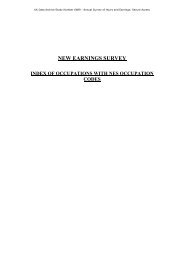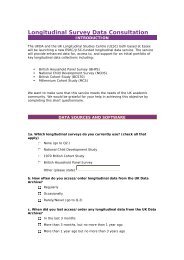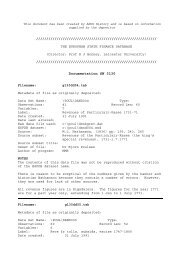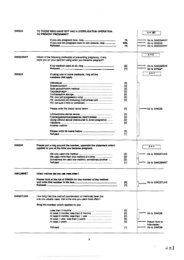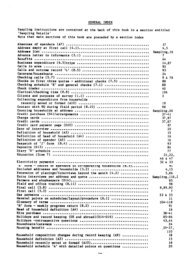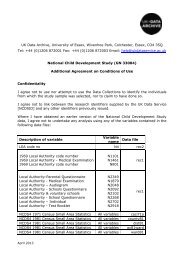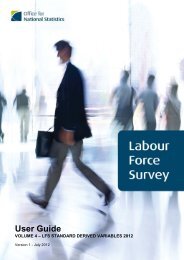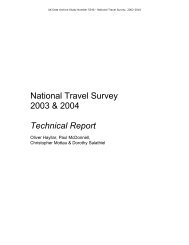ESDS Annual Report, 2008-2009
ESDS Annual Report, 2008-2009
ESDS Annual Report, 2008-2009
You also want an ePaper? Increase the reach of your titles
YUMPU automatically turns print PDFs into web optimized ePapers that Google loves.
Executive summary<br />
Each <strong>ESDS</strong> data delivery service presents a case study and a general report for<br />
<strong>2008</strong>-<strong>2009</strong>. These are followed by a statistical report for the whole of <strong>ESDS</strong>.<br />
In the case studies, <strong>ESDS</strong> Government spotlight the<br />
teaching of undergraduates in the use of advanced<br />
quantitative techniques, while <strong>ESDS</strong> International (macro)<br />
feature a study of the biases affecting corporate decisions<br />
on overseas investment. <strong>ESDS</strong> International (micro) focus<br />
on a study of children in poverty, while <strong>ESDS</strong> Longitudinal<br />
demonstrate the use of sampler datasets drawn from a<br />
survey of children born in the 1990s. <strong>ESDS</strong> Qualidata cite<br />
the re-use of data by students, while <strong>ESDS</strong> Access and<br />
Preservation give examples of how researchers interrogate<br />
a major psychiatric dataset.<br />
In their report, <strong>ESDS</strong> Government describe how the Essex<br />
and Manchester teams work together to create a unified<br />
service. Essex concentrates on building the collections,<br />
while Manchester promotes the collections for research<br />
and teaching and provides user support. During <strong>2008</strong>-<strong>2009</strong><br />
the service promoted the use of data in research by raising<br />
awareness with educators and by providing instruction in<br />
data analysis and related skills. Six successful meetings were<br />
held between data producers and data users, and there was<br />
continued effective outreach featuring posters and webbased<br />
resources.<br />
<strong>ESDS</strong> International reached its 20,000 th user during<br />
the reporting period. The service’s user community was<br />
extended, partly via YouTube and Twitter. New online<br />
resources and value-added services were developed, and<br />
new guides to important studies were released. New<br />
resources became available, including the UN’s Millennium<br />
Development Goals and the African Development Indicators<br />
were added to the data portfolio. The service held its<br />
fourth <strong>Annual</strong> Conference and presentations were made at<br />
conferences around the world.<br />
<strong>ESDS</strong> Longitudinal had its busiest ever year due to the<br />
ESRC’s emphasis on investing in longitudinal studies, such<br />
as Understanding Society and Timescapes. There were<br />
many updates to existing studies plus releases of several<br />
important waves and sweeps of data. Sampler files were<br />
piloted and the Conditional Access system was developed.<br />
New user resources were published such as web pages and<br />
‘useful notes’ and a steady flow of workshops was delivered.<br />
4 E C O N O M I C A N D S O C I A L DATA S E RV I C E A N N UA L R E P O RT AU G U S T 2 0 0 7 8 – J U LY 2 0 0 89<br />
<strong>ESDS</strong> Qualidata was very busy during <strong>2008</strong>-<strong>2009</strong>. Several<br />
new studies were added on subjects as varied as the social<br />
condition of older men and the role of television coverage<br />
of the Iraq war. Considerable effort went into teaching<br />
social scientists how to search and access the collections<br />
and how to do secondary analysis of data. Technical<br />
development continued including use of the semantic<br />
web and the processing of interview transcripts, while the<br />
tension between the archiving of data and the complex<br />
ethical issues arising from its re-use was explored.<br />
<strong>ESDS</strong> Access and Preservation continued to enhance the<br />
preservation systems at the UK Data Archive, moving the<br />
servers into a more robust environment and developing a<br />
metadata strategy to improve information development.<br />
The Lucene search engine was introduced, allowing users<br />
to conduct basic or advanced searches combining a range<br />
of variables across the catalogue. Developmental work was<br />
also carried out preparing for the integration in <strong>2009</strong>-2010<br />
of the Survey Resources Network (SRN) and the Secure<br />
Data Service (SDS), both funded by the ESRC.<br />
<strong>ESDS</strong> Management held a think tank in advance of the<br />
mid-term review of <strong>ESDS</strong>. This identified key areas where<br />
<strong>ESDS</strong> has made a clear impact, namely the generation<br />
of research activity, influence on policy making, and the<br />
teaching and instruction of future economists and social<br />
scientists. Preparatory work was also carried out on a<br />
new <strong>ESDS</strong> Collection Development Strategy and potential<br />
strategic alliances were developed, partly by welcoming<br />
visits from experts involved in data management.<br />
The statistical report demonstrates the growing user base of<br />
<strong>ESDS</strong>. Web site page hits and user queries continued to rise,<br />
the <strong>2008</strong> and <strong>2009</strong> figures being up on the previous year<br />
by 27 and 28 per cent respectively, The number of datasets<br />
delivered to users exceeded 50,000 for the first time, the<br />
increase in demand for <strong>ESDS</strong> Qualidata being especially<br />
noticeable. There was a 64 per cent increase in the datasets<br />
further processed for value-added delivery via Nesstar and<br />
Beyond 20/20, and there was a trebling of longitudinal<br />
datasets added to the collection and processed.




